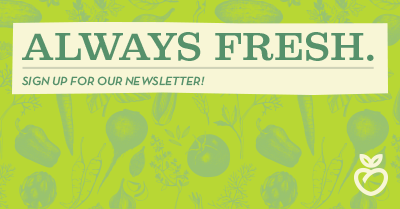Afield with Vermont Farmers

Farm season in Vermont is peaking, and to us at Healthy Living, this means it’s also farm trip season! Last Wednesday, a group of HL staff took a trip to several of our local producers’ fields (I guess that makes it a field trip??) to see what’s coming out of the ground and learn more about how it’s grown. To me, this opportunity to connect, to witness and to deepen our relationship with vendors is vital to being part of a business that supports local. For anyone who buys local, when we get to know our farmers, we enrich every bite and add value to every purchase by knowing who grew our food, what care they took in doing so, what they risked and sacrificed to make it possible, and what it means to them to bring it to us. I don’t think anyone we visited would mind another friend stopping by, so I highly encourage you to make a pilgrimage to your local farms and let them know you love their food! I swear, it makes the veggies grow bigger…

What struck me most about this farm trip was how different each farm is. So different, in fact, that it reminded me of the four student houses in Harry Potter’s Hogwarts School. Each house, and each farm had its strengths and its weaknesses, its characteristics and its aversions, and these differences are what make them all worth appreciating. When we all play to our strengths and diversify, a rainbow of bounty (and a stronger food system) is the result. As with people, I’m sure glad every farm isn’t the same…how boring would that be?

Our first stop of the day was on Grand Isle at MR Sol Farm. MR Sol—formerly MR Harvest —is certified organic and run by Dave McGregor of MR Harvest and his partner Greg Sol, formerly of Sol Fresh Farm in Charlotte. Dave and Greg together manage several high tunnels as well as two sets of fields in diversified vegetable production. Dave grew up on the farm, which started as a large flower garden under his father’s hand and grew into what it is today, 25 acres of intensively cropped land.

The farm is still recovering from a very wet season last year, which had a big impact on the diversity of their crops. This year, they are working on restoring variety to their fields, with moderate success. Dave was quite honest with us when showing certain heirloom species, explaining that they can be more fickle and susceptible to environmental factors than their more common descendents, and a risk to grow.

It’s obvious that Dave has to make tough choices between offering more to his customers and protecting his business, but his positive attitude more than makes up for any disappointments. I’ve never met a farmer so determined to problem-solve and willing to try anything and everything to squeeze the most out of his acres.

And I wasn’t fooled by his less-than-perfect fields, which were unapologetically weedy—ever since we started receiving boxes from him back in April, I am consistently impressed with the quality of his produce, which is unmatched and stands out from our already exceptional shelves, practically glowing with vitality.

After being invited to pick right from his plants on our tour, we stepped into his walk-in to conclude the visit and found it impossible to stop him from filling an overflowing box of his best produce for us to take home. Dave’s generosity, ethics and above all, his down-to-earth honesty all impressed me greatly. You can taste the best by looking for MR Sol’s yellow and red onions, cucumbers and eggplant, gold beets and green cabbage, scallions and a mess of tomatoes this week in Healthy Living Produce.

We continued on our rainy journey to Savage Point Road on North Hero, home to Savage Gardens. They are probably most famous for their delicious eggs, but what I didn’t know is that they also have a bustling farm stand and extensive gardens. I can also personally attest to their having extra tasty meat birds, after bringing home a fresh one and roasting it whole.

HL is currently carrying their beautiful red and blue new potatoes, which I can’t get enough of—did I mention I roasted my chicken on a bed of them? Be sure you visit their happy farm to pick up a fresh bird if you get a chance.

Hugo and Amanda Gervais started growing on the property after building their home in 2001. Amanda’s garden grew and brought her to local farmers’ markets, and eventually animals were added to the mix and Hugo joined her to farm full-time. The diversity of their farm is amazing for its size—quite small, that is. This land supports thousands of laying hens, broiler birds, their 3 dairy cows—yes, they sell raw milk—and a cornucopia of fresh produce, as well as cut flowers. They also sell piglets! We met their 4 pigs who were friendly and frolicksome.


They now farm 30 acres in North Hero and 60 in Isle Lamotte, practicing rotation with their animals and cultivation. This means that the fields for planting have been pre-fertilized by the chickens, who were pastured on them the year before. This practice ensures the long-term viability of the land for growing and minimizes the need for inputs and pest management. They are certified organic and clearly care deeply about their land and creatures, great and small.


Hugo and Amanda are incredibly humble and warm people and spent a long time talking with us, which shows me how much they value their supporters. They have two young children and while they did recently built housing for their handful of seasonal employees, it was so beautiful to witness a family farm run by folks who are doing it themselves and for love and have a true passion for growing and raising. You can find more of their produce (and sometimes chicken!) at the Fletcher Allen Farmers’ market on Thursdays’, as well as weekly markets on the Islands.

After we dried off and ate some lunch, it was down to the Intervale our group went next. Our first stop was Half Pint Farm, which is leased by Mara and Spencer Welton.

Half Pint’s philosophy boils down to a whole lot of planning, seed saving and a very specific focus: specialty and heirloom varieties. Specifically, tiny versions of heirloom varieties—think baby squash, microgreens, cherry tomatoes, hot peppers, baby lettuce… And their farm is correspondingly tiny. Don’t be fooled by its’ size, though—comprised of just 2 acres, it boasts close to 400 varieties of vegetables.

I think micro-managed is the appropriate term here—as Mara said, “we are a spreadsheet farm”—but far from obsessive, it’s incredibly inspiring to listen to her talk about her passion for overseeing the cropping, bringing in new varieties and experimenting to learn what works and what doesn’t. In regards to what doesn’t work, I found their approach very interesting —when a crop falls victim to disease or pests, they don’t fight at all. They let nature take its course and instead focus on what’s doing well. And on a farm with so many varieties of a given crop, they can afford to do this, which is fortunate.

During the winter, which Mara calls “conference season”, they are traveling and sharing their techniques with other farmers and learning new ways to improve their return. This combined with subscribing to as many food magazines as she can get her hands on is what allows Mara to be perched on the cutting edge of food trends and still drawing on traditional grower wisdom.

For example, among the bouquet beds for CSA members she pointed out sunflowers whose heads had not yet opened. These large buds look somewhat like baby artichokes, and she had heard that if steamed, they could be eaten much the same way. She was going to try it out and if it got her approval, the sunflower buds would go into her CSA boxes for the week. This kind of experimentation in a farm share wouldn’t be everyone’s way of doing things, but they have cultivated a customer base who are as enthusiastic about slow food as they are, and it works.

As we walked around the small farm, it was as clear there as it was at all of the farms that it’s tomato and pepper time right now. I couldn’t keep track of all the varieties of each that they have growing, not to mention the jumble of mature squashes on the ground (don’t forget about those squash blossoms, either).

I saw cuke-o-melons and sunchokes growing for the first time, and even got to taste the elusive Trinidad Perfume, a habanero variety with no heat. I never knew habaneros had so much flavor!

Leaving Half Pint, I was most impressed by the obvious success they have had working within self-imposed parameters. A small farm size, a tight plan and a specific focus all have helped Half Pint succeed as a specialty producer that customers seek out time and again for exceptional food. While other farms, such as Savage Gardens, are looking to grow all the time, Half Pint seems pretty content to be the mini-farm that it is.

Speaking of growth, our last stop of the day was just down potholed and puddled Intervale Road at Diggers’ Mirth. 22 years ago, Diggers’ started as another small Intervale farm, and season by season it has grown into the essential and dependable mid-sized farm that it is. They have acquired several additional fields in the Intervale, allowing them to grow specialty crops for their diverse customer base, as well as expand their “bread and butter” crops: salad greens.

Hilary, one of the partners, explained to us as we traipsed through the rain that the 5 of them track their hours worked, and at the end of the year they divvy up their profits accordingly. This system allows them to travel, work other jobs, and get out what they put in.
The other thing Hilary emphasized is their mission to make fresh food accessible to as many people as possible—this is what got the collective started in the first place. The Diggers’ Mirth Farm Truck rolls through the streets of Burlington’s Old North End, a mobile veggie disco with a mission: bring the food to the people. The price is right on this produce and it’s very important to the Diggers’ crew to keep paying it forward.

Though farmers have come and gone from the collective, they share the same core values, and the same ability to grow amazing food. You’ll regularly see their fresh herbs on our shelves, such as parsley, cilantro and dill, as well as piles of bagged mesculun and spinach. Keep your eyes peeled soon for their oblong Sangria watermelons—the best I’ve ever had.

Seeing and hearing all of these people share their farm stories with us and thinking about their diverse backgrounds and approaches was a powerful experience for me, as it would be for any eater. Whether it’s by cunning, hard work, love, or dumb luck, these 4 farms are all growing amazing produce and working true magic in the fields. I am proud to be a part of helping support them and bring their food to the people. But don’t let us do all the work! Bring your people to the food—visit your local farmers today! It’s a trip I won’t soon forget.



